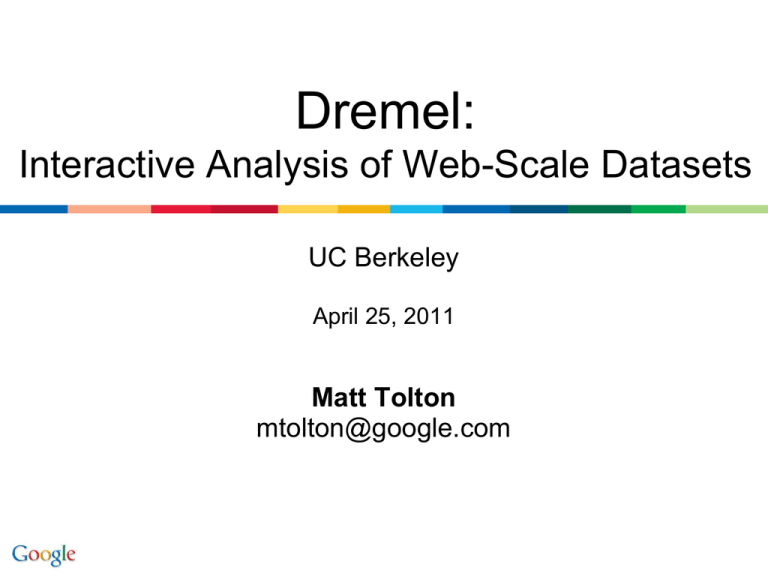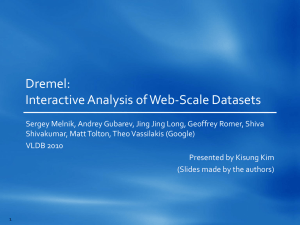dremel
advertisement

Dremel:
Interactive Analysis of Web-Scale Datasets
UC Berkeley
April 25, 2011
Matt Tolton
mtolton@google.com
Data mgmt at Google
sample from http://research.google.com/pubs/papers.html
• Classics
– GFS [SOSP’03]: distributed file system
– Bigtable [OSDI’06]: key/value store
– MapReduce [OSDI’04]: batch-oriented processing
– Sawzall [Sci.Pr.’05]: PL on top of MR
• Recent
– Pregel [SIGMOD’10]: Graph mining
– FlumeJava [PLDI’10]: Java library for data-parallel pipelines
– Megastore [to appear in CIDR’11]
• Transactions, consistent repl., secondary idx on top of BT
2
Large-scale data analysis
• Data analysis is lifeblood of many companies
• Parallel database systems
– Not designed for extreme scale
• MapReduce [Dean, Ghemawat ’04]
– Fault-tolerant data processing
• Can be used to execute queries!
– Not designed for low latency (coding, batch jobs)
• SQL et al layers on MR (e.g., Hive, Pig, Sawzall)
• DBMS/MR hybrids (e.g., Aster, Cloudera, HadoopDB)
3
Interactive speed
• What does it take to run queries on
1,000,000,000,000 records in seconds?
• Dremel: data analysis tool that uses speed
instead of raw power
Brand of power tools that primarily rely on
their speed as opposed to torque
• Based on VLDB’10 paper
– Sergey Melnik, Andrey Gubarev, Jing Jing Long, Geoffrey
Romer, Shiva Shivakumar, Matt Tolton, Theo Vassilakis
4
Key features
• Interactive speed at very large scale
– Multi-TB datasets, 1000s of nodes
– Fault and straggler tolerant execution
– Columnar storage and processing
– Tree architecture (as in web search)
• Nested data model w/ SQL-like language
– 1000s of fields, deeply nested
– Normalization is prohibitive
• Interoperates with Google's data mgmt tools
– In situ (in place) data access (e.g., GFS, Bigtable)
5
MR and Dremel execution
Processing an 85 billion record table
Execution time (sec) on 3000 nodes
87 TB
0.5 TB
0.5 TB
MR overheads: launch jobs, schedule 0.5M tasks, assemble records
6
Makes engineers more
productive
1
Runs a MapReduce to extract
billions of signals from web pages
Googler Alice
2
What’s the best way to use new signals?
DEFINE TABLE t AS /path/to/data/*
SELECT TOP(signal, 100), COUNT(*) FROM t
. . .
3
Feed into another MR pipeline or serving system
7
Widely used inside Google
• Analysis of crawled web
documents
• Tracking install data for
applications on Android Market
• Crash reporting for Google
products
• OCR results from Google
Books
• Spam analysis
• Debugging of map tiles on
Google Maps
• Tablet migrations in managed
Bigtable instances
• Results of tests run on
Google's distributed build
system
• Disk I/O statistics for
hundreds of thousands of
disks
• Resource monitoring for jobs
run in Google's data centers
• Symbols and dependencies
in Google's codebase
10s/1000s-node instances in several data centers
8
9
NESTED COLUMNAR STORAGE
(COLUMNIO)
10
Records
vs.
columns
A
*
*
...
B
r1
C
r2
...
r1
r2
Read less,
cheaper
decompression
*
r1
D
E
r1
r2
r2
Challenge: preserve structure, reconstruct from a subset of fields
11
Nested data model
r
http://code.google.com/apis/protocolbuffers
multiplicity:
message Document {
required int64 DocId;
optional group Links {
repeated int64 Backward;
repeated int64 Forward;
}
repeated group Name {
repeated group Language {
required string Code;
optional string Country;
}
optional string Url;
}
}
[1,1]
[0,*]
[0,1]
DocId: 10
1
Links
Forward: 20
Forward: 40
Forward: 60
Name
Language
Code: 'en-us'
Country: 'us'
Language
Code: 'en'
Url: 'http://A'
Name
Url: 'http://B'
Name
Language
Code: 'en-gb'
Country: 'gb'
r
DocId: 20
2
Links
Backward: 10
Backward: 30
Forward: 80
Name
Url: 'http://C'
12
ColumnIO representation
value
r
d
Name.Ur
l
value
r
10
0
0
http://A
0
2
20
0
2
NULL
0
1
20
0
0
http://B
1
2
40
1
2
10
0
2
NULL
1
1
60
1
2
30
1
2
http://C
0
2
80
0
2
DocId
Links.Forward
Links.Backward
d
value
r
d
value
r
d
Name.Language.Code
Name.Language.Country
value
r
d
value
r
d
en-us
0
2
us
0
3
en
2
2
NULL
2
2
NULL
1
1
NULL
1
1
en-gb
1
2
gb
1
3
NULL
0
1
NULL
0
1
13
Repetition and
definition levels
Name.Language.Code
: common prefix
value
r
d
en-us
0
2
r1.Name1.Language1.Code: 'en-us'
en
2
2
r1.Name1.Language2.Code: 'en'
NULL
1
1
en-gb
1
2
r1.Name2
r1.Name3.Language1.Code: 'en-gb'
NULL
0
1
r2.Name1
Repetition and definition levels encode the structural
delta between the current value and the previous value.
r: length of common path prefix
d: length of the current path
DocId: 10
Links
Forward: 20
Forward: 40
Forward: 60
Name
Language
Code: 'en-us'
Country: 'us'
Language
Code: 'en'
Url: 'http://A'
Name
Url: 'http://B'
Name
Language
Code: 'en-gb'
Country: 'gb'
DocId: 20
Links
Backward: 10
Backward: 30
Forward: 80
Name
Url: 'http://C'
Record assembly FSM
Transitions
labeled with
repetition levels
DocId
0
1
Links.Backward
0
Links.Forward
1
0
Name.Language.Code
0,1,2
Name.Language.Country
2
1
Name.Ur
l
0
0,1
For record-oriented data processing (e.g., MapReduce)
15
Reading two fields
Both Dremel and
MapReduce can read
same columnar data
s
DocId
0
1,2
Name.Language.Country
0
DocId: 10
1
Name
Language
Country: 'us'
Language
Name
Name
Language
Country: 'gb'
DocId: 20
Name
s2
• Structure of parent fields is preserved.
• Useful for queries like /Name[3]/Language[1]/Country
• Selective assembly (vs. full assembly in XMill [Liefke, Suciu '00])
16
"cold" time on local disk,
averaged over 30 runs
Selective assembly
time (sec)
from records
(e) parse as
C++ objects
10x speedup
using columnar
storage
objects
(d) read +
decompress
2-4x overhead of
using records
from columns
records
columns
(c) parse as
C++ objects
(b) assemble
records
(a) read +
decompress
number of fields
Tablet: 375 MB (compressed), 300K rows, 125 columns
17
18
HIERARCHICAL QUERY
PROCESSING
19
Query processing architecture
• Optimized for select-project-aggregate
– Very common class of interactive queries
– Single scan
– Within-record and cross-record aggregation
• Unit of storage: tablet
– Self-contained horizontal partition of a table
Schema
Metadata
keys, order, ranges, …
Data
C1
…
Cn
• Unit of execution: slot
– Thread on a server
– E.g., 3K servers × 8 threads = 24K slots
20
Serving tree
[Dean WSDM'09]
client
• Parallelizes scheduling
and aggregation
root server
• Fault tolerance
intermediate
servers
leaf servers
(with local
storage)
...
...
• Stragglers
• Designed for "small"
results (<1M records)
...
storage layer (e.g., GFS)
21
Example: count()
0
1
SELECT A, COUNT(B) FROM T
GROUP BY A
T = {/gfs/1, /gfs/2, …, /gfs/100000}
SELECT A, SUM(c)
FROM (R11 UNION ALL R110)
GROUP BY A
R11
R 12
SELECT A, COUNT(B) AS c
FROM T11 GROUP BY A
T11 = {/gfs/1, …, /gfs/10000}
SELECT A, COUNT(B) AS c
FROM T12 GROUP BY A
T12 = {/gfs/10001, …, /gfs/20000}
...
...
3
SELECT A, COUNT(B) AS c
FROM T31 GROUP BY A
T31 = {/gfs/1}
...
Data access ops
22
Impact of serving tree depth
execution time (sec)
(returns 100s of records)
The deeper the tree,
the better we can
parallelize aggregation
(returns 1M records)
Q2:
SELECT country, SUM(item.amount) FROM T2
GROUP BY country
Q3:
SELECT domain, SUM(item.amount) FROM T2
WHERE domain CONTAINS ’.net’
GROUP BY domain
40 billion nested items
23
Scalability
execution time (sec)
number of
leaf servers
Q5 on a trillion-row table T4 (total read: 4.2 TB)
SELECT TOP(aid, 20), COUNT(*) FROM T4
WHERE bid = {value1} AND cid = {value2}
24
Stragglers at 2× replication
percentage of processed tablets
stragglers
processing time per tablet (sec)
Q6: approximate query on a trillion-row table T5 (total read: 1TB)
SELECT COUNT(DISTINCT a) FROM T5
25
SQL dialect for nested data
SELECT DocId AS Id,
COUNT(Name.Language.Code) WITHIN Name AS Cnt,
Name.Url + ',' + Name.Language.Code AS Str
FROM t
WHERE REGEXP(Name.Url, '^http') AND DocId < 20;
Output table
Output schema
Id: 10
t1
Name
Cnt: 2
Language
Str: 'http://A,en-us'
Str: 'http://A,en'
Name
Cnt: 0
message QueryResult {
required int64 Id;
repeated group Name {
optional uint64 Cnt;
repeated group Language {
optional string Str;
}
}
}
No record assembly during distributed query processing
26
Other features
• In the paper
– Algorithms: select-project-aggregate evaluation,
column-striping, record assembly, FSM construction
• Not in the paper
– Joins, User-defined scalar and table valued
functions, materialized results
– Approximate queries (count distinct, top-k)
– Cross-data center replication
– Quality of service
– Bulk updates
27
28
OBSERVATIONS
29
Interactive speed
Monthly query workload
of one 3000-node
Dremel instance
percentage of queries
execution
time (sec)
Most queries complete under 10 sec
30
What we learned
• Possible to analyze large disk-resident datasets
interactively on commodity hardware
– 1T records, 1000s of nodes
• MR can benefit from columnar storage just like
parallel DBMSes
– But record assembly is expensive
• Parallel DBMSes may benefit from serving tree
architecture just like search engines
• Interactive SQL and MR can be complementary
• Getting to last few percent of data fast is hard
– Replication, approximation, early termination
31
BigQuery: powered by Dremel
http://code.google.com/apis/bigquery/
Your Data
1. Upload
Upload your data
to Google Storage
BigQuery
2. Process
Import to tables
Your Apps
3. Act
Run queries
32







